SXL3121: A Critical Discussion on Corporate Veil Piercing
VerifiedAdded on 2023/04/22
|12
|4129
|431
Essay
AI Summary
This essay critically examines the concept of corporate veil piercing in partnerships and company law, reflecting on judicial, statutory, and academic authorities. It begins by evaluating the separate corporate personality and its consequences, followed by an explanation of the concept and approaches to piercing the corporate veil, highlighting its development through judicial precedents like Salomon v Salomon & Co Ltd and Prest v Petrodel Resources Ltd, as well as statutory provisions such as the Companies Act 2006. The essay discusses the evasion and concealment principles used by courts and concludes that while the concept is universally accepted to prevent misuse of a company's separate legal personality, it remains an enigma due to its uncertain and ill-defined application. The analysis also incorporates the significance of dishonesty and abuse of incorporation privileges in determining when to lift the corporate veil.
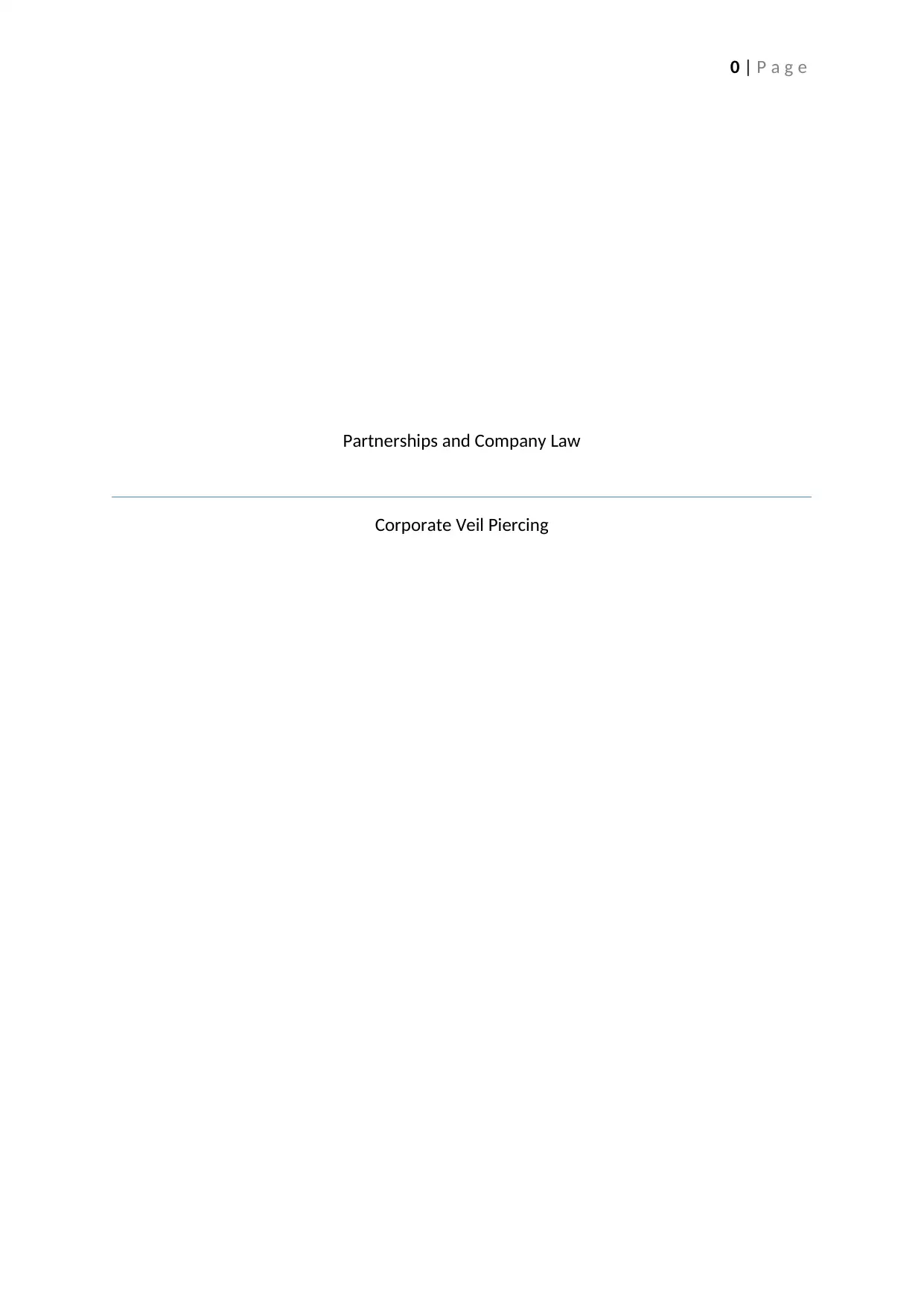
0 | P a g e
Partnerships and Company Law
Corporate Veil Piercing
Partnerships and Company Law
Corporate Veil Piercing
Paraphrase This Document
Need a fresh take? Get an instant paraphrase of this document with our AI Paraphraser
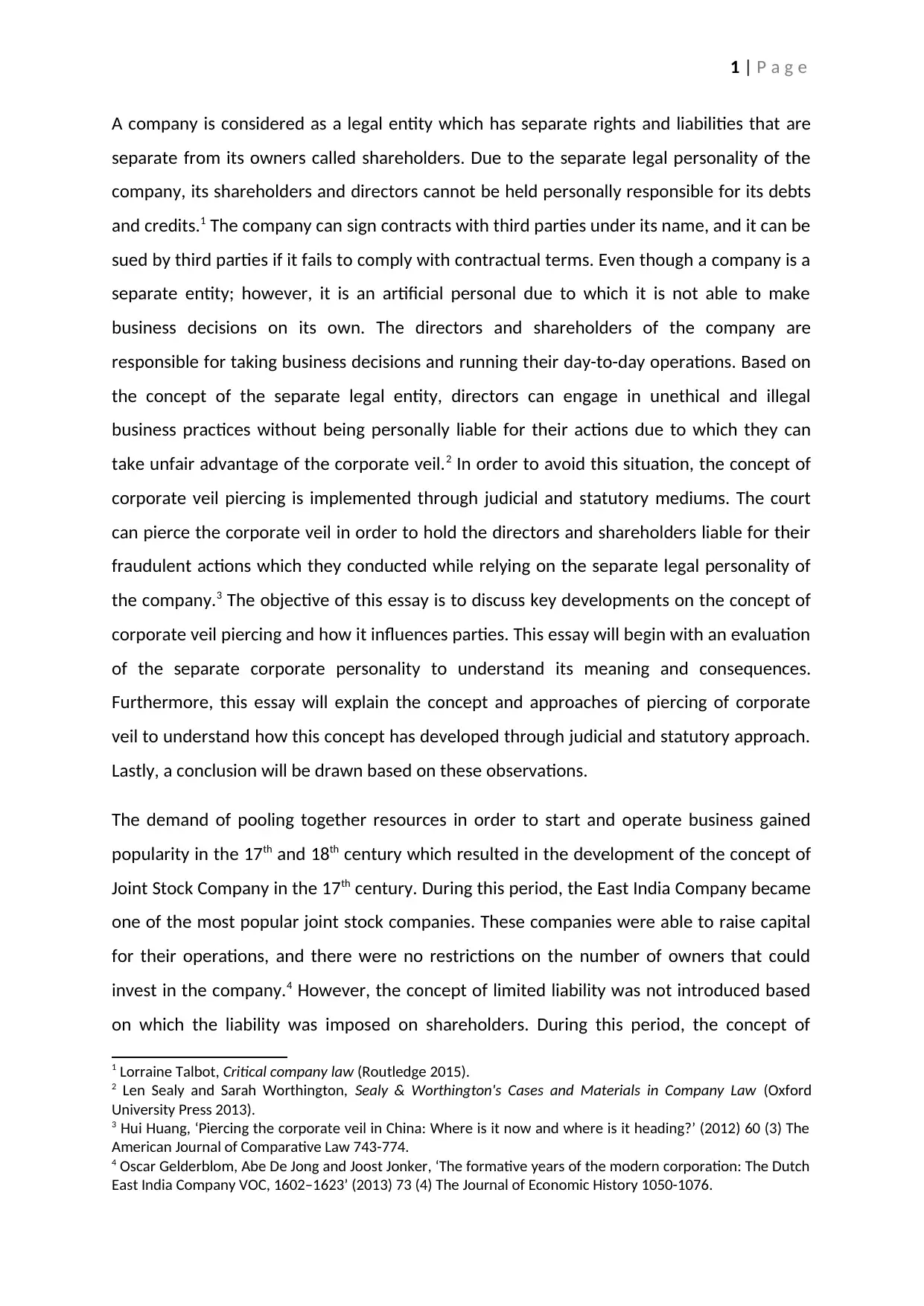
1 | P a g e
A company is considered as a legal entity which has separate rights and liabilities that are
separate from its owners called shareholders. Due to the separate legal personality of the
company, its shareholders and directors cannot be held personally responsible for its debts
and credits.1 The company can sign contracts with third parties under its name, and it can be
sued by third parties if it fails to comply with contractual terms. Even though a company is a
separate entity; however, it is an artificial personal due to which it is not able to make
business decisions on its own. The directors and shareholders of the company are
responsible for taking business decisions and running their day-to-day operations. Based on
the concept of the separate legal entity, directors can engage in unethical and illegal
business practices without being personally liable for their actions due to which they can
take unfair advantage of the corporate veil.2 In order to avoid this situation, the concept of
corporate veil piercing is implemented through judicial and statutory mediums. The court
can pierce the corporate veil in order to hold the directors and shareholders liable for their
fraudulent actions which they conducted while relying on the separate legal personality of
the company.3 The objective of this essay is to discuss key developments on the concept of
corporate veil piercing and how it influences parties. This essay will begin with an evaluation
of the separate corporate personality to understand its meaning and consequences.
Furthermore, this essay will explain the concept and approaches of piercing of corporate
veil to understand how this concept has developed through judicial and statutory approach.
Lastly, a conclusion will be drawn based on these observations.
The demand of pooling together resources in order to start and operate business gained
popularity in the 17th and 18th century which resulted in the development of the concept of
Joint Stock Company in the 17th century. During this period, the East India Company became
one of the most popular joint stock companies. These companies were able to raise capital
for their operations, and there were no restrictions on the number of owners that could
invest in the company.4 However, the concept of limited liability was not introduced based
on which the liability was imposed on shareholders. During this period, the concept of
1 Lorraine Talbot, Critical company law (Routledge 2015).
2 Len Sealy and Sarah Worthington, Sealy & Worthington's Cases and Materials in Company Law (Oxford
University Press 2013).
3 Hui Huang, ‘Piercing the corporate veil in China: Where is it now and where is it heading?’ (2012) 60 (3) The
American Journal of Comparative Law 743-774.
4 Oscar Gelderblom, Abe De Jong and Joost Jonker, ‘The formative years of the modern corporation: The Dutch
East India Company VOC, 1602–1623’ (2013) 73 (4) The Journal of Economic History 1050-1076.
A company is considered as a legal entity which has separate rights and liabilities that are
separate from its owners called shareholders. Due to the separate legal personality of the
company, its shareholders and directors cannot be held personally responsible for its debts
and credits.1 The company can sign contracts with third parties under its name, and it can be
sued by third parties if it fails to comply with contractual terms. Even though a company is a
separate entity; however, it is an artificial personal due to which it is not able to make
business decisions on its own. The directors and shareholders of the company are
responsible for taking business decisions and running their day-to-day operations. Based on
the concept of the separate legal entity, directors can engage in unethical and illegal
business practices without being personally liable for their actions due to which they can
take unfair advantage of the corporate veil.2 In order to avoid this situation, the concept of
corporate veil piercing is implemented through judicial and statutory mediums. The court
can pierce the corporate veil in order to hold the directors and shareholders liable for their
fraudulent actions which they conducted while relying on the separate legal personality of
the company.3 The objective of this essay is to discuss key developments on the concept of
corporate veil piercing and how it influences parties. This essay will begin with an evaluation
of the separate corporate personality to understand its meaning and consequences.
Furthermore, this essay will explain the concept and approaches of piercing of corporate
veil to understand how this concept has developed through judicial and statutory approach.
Lastly, a conclusion will be drawn based on these observations.
The demand of pooling together resources in order to start and operate business gained
popularity in the 17th and 18th century which resulted in the development of the concept of
Joint Stock Company in the 17th century. During this period, the East India Company became
one of the most popular joint stock companies. These companies were able to raise capital
for their operations, and there were no restrictions on the number of owners that could
invest in the company.4 However, the concept of limited liability was not introduced based
on which the liability was imposed on shareholders. During this period, the concept of
1 Lorraine Talbot, Critical company law (Routledge 2015).
2 Len Sealy and Sarah Worthington, Sealy & Worthington's Cases and Materials in Company Law (Oxford
University Press 2013).
3 Hui Huang, ‘Piercing the corporate veil in China: Where is it now and where is it heading?’ (2012) 60 (3) The
American Journal of Comparative Law 743-774.
4 Oscar Gelderblom, Abe De Jong and Joost Jonker, ‘The formative years of the modern corporation: The Dutch
East India Company VOC, 1602–1623’ (2013) 73 (4) The Journal of Economic History 1050-1076.
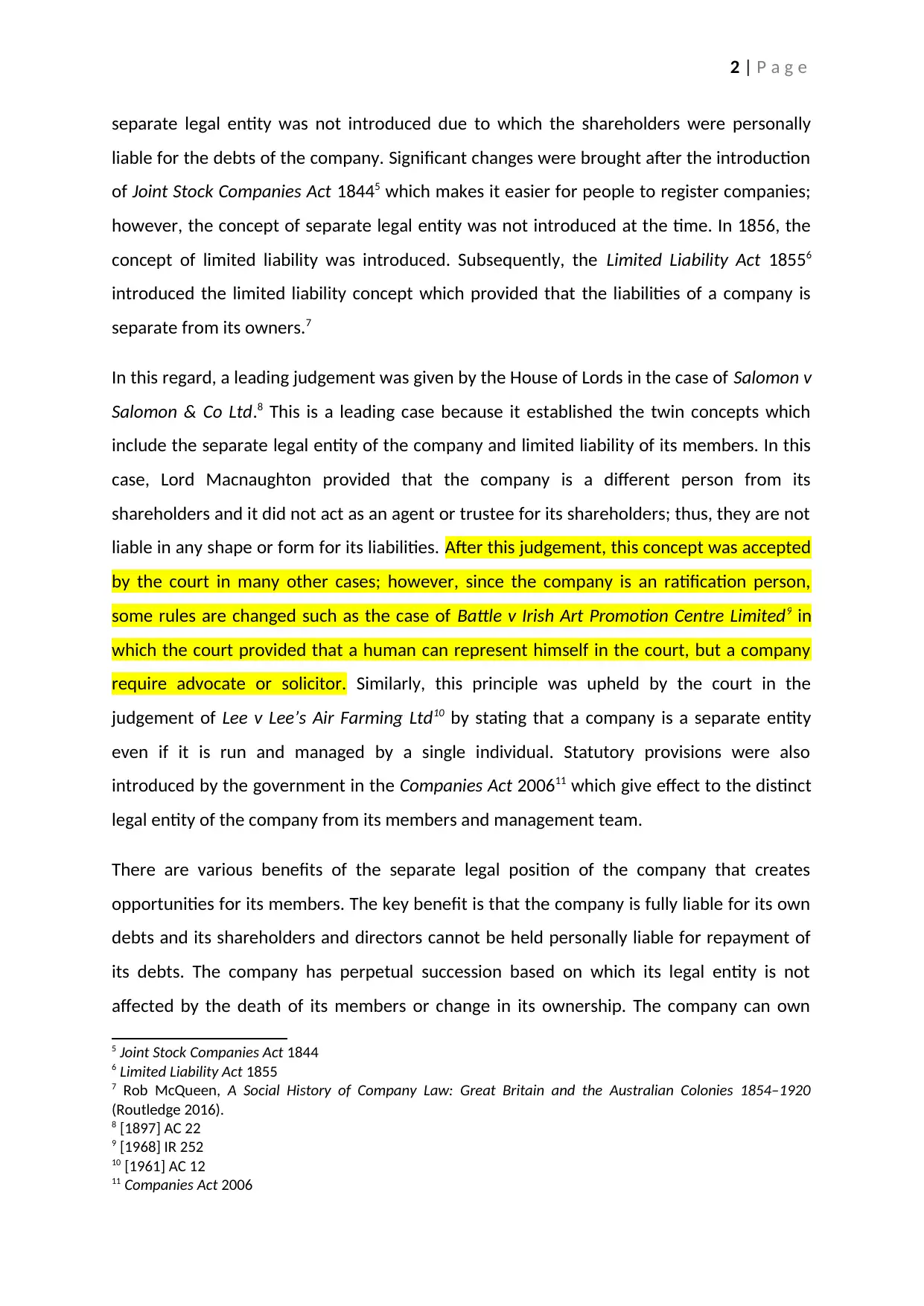
2 | P a g e
separate legal entity was not introduced due to which the shareholders were personally
liable for the debts of the company. Significant changes were brought after the introduction
of Joint Stock Companies Act 18445 which makes it easier for people to register companies;
however, the concept of separate legal entity was not introduced at the time. In 1856, the
concept of limited liability was introduced. Subsequently, the Limited Liability Act 18556
introduced the limited liability concept which provided that the liabilities of a company is
separate from its owners.7
In this regard, a leading judgement was given by the House of Lords in the case of Salomon v
Salomon & Co Ltd.8 This is a leading case because it established the twin concepts which
include the separate legal entity of the company and limited liability of its members. In this
case, Lord Macnaughton provided that the company is a different person from its
shareholders and it did not act as an agent or trustee for its shareholders; thus, they are not
liable in any shape or form for its liabilities. After this judgement, this concept was accepted
by the court in many other cases; however, since the company is an ratification person,
some rules are changed such as the case of Battle v Irish Art Promotion Centre Limited9 in
which the court provided that a human can represent himself in the court, but a company
require advocate or solicitor. Similarly, this principle was upheld by the court in the
judgement of Lee v Lee’s Air Farming Ltd10 by stating that a company is a separate entity
even if it is run and managed by a single individual. Statutory provisions were also
introduced by the government in the Companies Act 200611 which give effect to the distinct
legal entity of the company from its members and management team.
There are various benefits of the separate legal position of the company that creates
opportunities for its members. The key benefit is that the company is fully liable for its own
debts and its shareholders and directors cannot be held personally liable for repayment of
its debts. The company has perpetual succession based on which its legal entity is not
affected by the death of its members or change in its ownership. The company can own
5 Joint Stock Companies Act 1844
6 Limited Liability Act 1855
7 Rob McQueen, A Social History of Company Law: Great Britain and the Australian Colonies 1854–1920
(Routledge 2016).
8 [1897] AC 22
9 [1968] IR 252
10 [1961] AC 12
11 Companies Act 2006
separate legal entity was not introduced due to which the shareholders were personally
liable for the debts of the company. Significant changes were brought after the introduction
of Joint Stock Companies Act 18445 which makes it easier for people to register companies;
however, the concept of separate legal entity was not introduced at the time. In 1856, the
concept of limited liability was introduced. Subsequently, the Limited Liability Act 18556
introduced the limited liability concept which provided that the liabilities of a company is
separate from its owners.7
In this regard, a leading judgement was given by the House of Lords in the case of Salomon v
Salomon & Co Ltd.8 This is a leading case because it established the twin concepts which
include the separate legal entity of the company and limited liability of its members. In this
case, Lord Macnaughton provided that the company is a different person from its
shareholders and it did not act as an agent or trustee for its shareholders; thus, they are not
liable in any shape or form for its liabilities. After this judgement, this concept was accepted
by the court in many other cases; however, since the company is an ratification person,
some rules are changed such as the case of Battle v Irish Art Promotion Centre Limited9 in
which the court provided that a human can represent himself in the court, but a company
require advocate or solicitor. Similarly, this principle was upheld by the court in the
judgement of Lee v Lee’s Air Farming Ltd10 by stating that a company is a separate entity
even if it is run and managed by a single individual. Statutory provisions were also
introduced by the government in the Companies Act 200611 which give effect to the distinct
legal entity of the company from its members and management team.
There are various benefits of the separate legal position of the company that creates
opportunities for its members. The key benefit is that the company is fully liable for its own
debts and its shareholders and directors cannot be held personally liable for repayment of
its debts. The company has perpetual succession based on which its legal entity is not
affected by the death of its members or change in its ownership. The company can own
5 Joint Stock Companies Act 1844
6 Limited Liability Act 1855
7 Rob McQueen, A Social History of Company Law: Great Britain and the Australian Colonies 1854–1920
(Routledge 2016).
8 [1897] AC 22
9 [1968] IR 252
10 [1961] AC 12
11 Companies Act 2006
⊘ This is a preview!⊘
Do you want full access?
Subscribe today to unlock all pages.

Trusted by 1+ million students worldwide
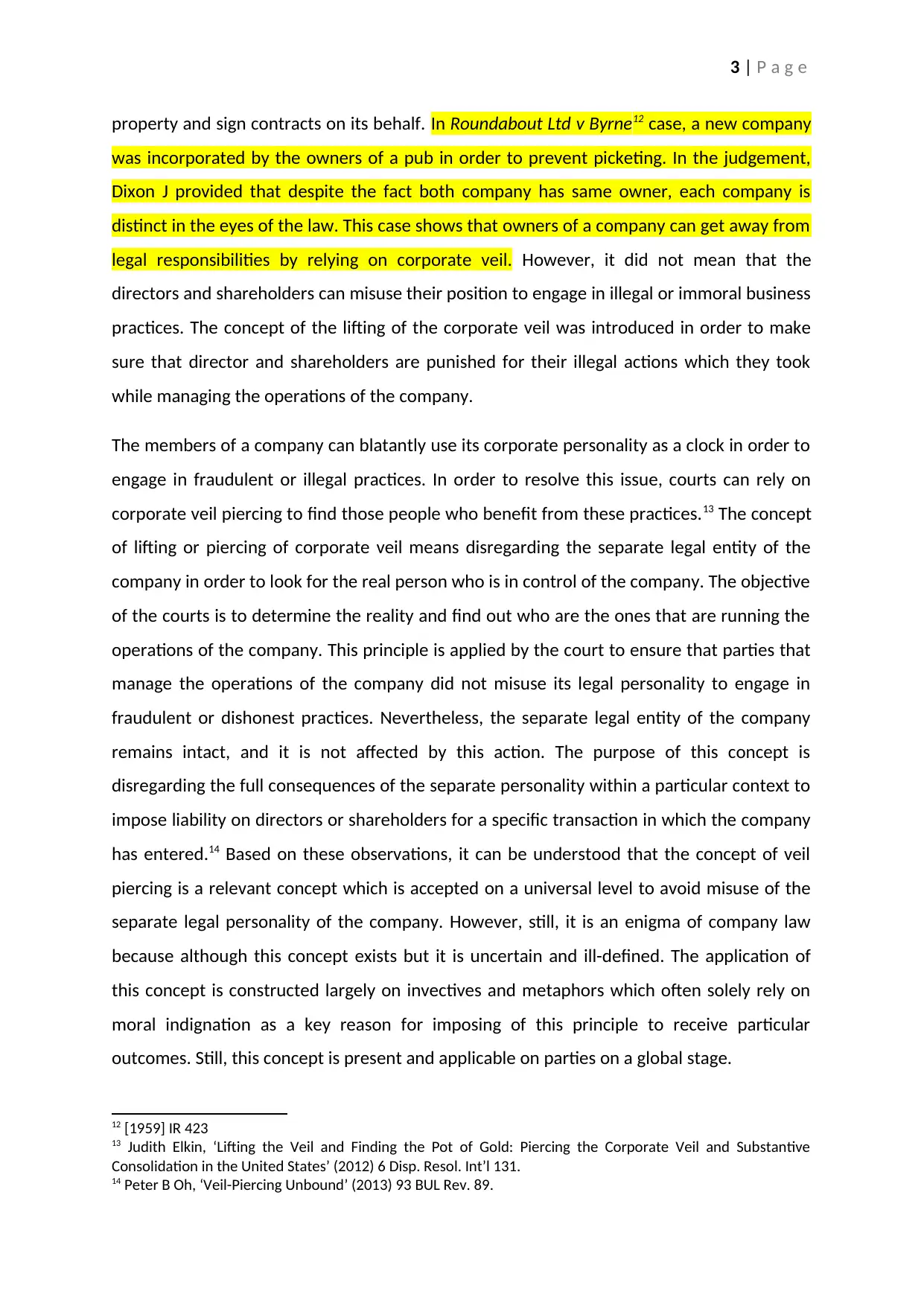
3 | P a g e
property and sign contracts on its behalf. In Roundabout Ltd v Byrne12 case, a new company
was incorporated by the owners of a pub in order to prevent picketing. In the judgement,
Dixon J provided that despite the fact both company has same owner, each company is
distinct in the eyes of the law. This case shows that owners of a company can get away from
legal responsibilities by relying on corporate veil. However, it did not mean that the
directors and shareholders can misuse their position to engage in illegal or immoral business
practices. The concept of the lifting of the corporate veil was introduced in order to make
sure that director and shareholders are punished for their illegal actions which they took
while managing the operations of the company.
The members of a company can blatantly use its corporate personality as a clock in order to
engage in fraudulent or illegal practices. In order to resolve this issue, courts can rely on
corporate veil piercing to find those people who benefit from these practices.13 The concept
of lifting or piercing of corporate veil means disregarding the separate legal entity of the
company in order to look for the real person who is in control of the company. The objective
of the courts is to determine the reality and find out who are the ones that are running the
operations of the company. This principle is applied by the court to ensure that parties that
manage the operations of the company did not misuse its legal personality to engage in
fraudulent or dishonest practices. Nevertheless, the separate legal entity of the company
remains intact, and it is not affected by this action. The purpose of this concept is
disregarding the full consequences of the separate personality within a particular context to
impose liability on directors or shareholders for a specific transaction in which the company
has entered.14 Based on these observations, it can be understood that the concept of veil
piercing is a relevant concept which is accepted on a universal level to avoid misuse of the
separate legal personality of the company. However, still, it is an enigma of company law
because although this concept exists but it is uncertain and ill-defined. The application of
this concept is constructed largely on invectives and metaphors which often solely rely on
moral indignation as a key reason for imposing of this principle to receive particular
outcomes. Still, this concept is present and applicable on parties on a global stage.
12 [1959] IR 423
13 Judith Elkin, ‘Lifting the Veil and Finding the Pot of Gold: Piercing the Corporate Veil and Substantive
Consolidation in the United States’ (2012) 6 Disp. Resol. Int’l 131.
14 Peter B Oh, ‘Veil-Piercing Unbound’ (2013) 93 BUL Rev. 89.
property and sign contracts on its behalf. In Roundabout Ltd v Byrne12 case, a new company
was incorporated by the owners of a pub in order to prevent picketing. In the judgement,
Dixon J provided that despite the fact both company has same owner, each company is
distinct in the eyes of the law. This case shows that owners of a company can get away from
legal responsibilities by relying on corporate veil. However, it did not mean that the
directors and shareholders can misuse their position to engage in illegal or immoral business
practices. The concept of the lifting of the corporate veil was introduced in order to make
sure that director and shareholders are punished for their illegal actions which they took
while managing the operations of the company.
The members of a company can blatantly use its corporate personality as a clock in order to
engage in fraudulent or illegal practices. In order to resolve this issue, courts can rely on
corporate veil piercing to find those people who benefit from these practices.13 The concept
of lifting or piercing of corporate veil means disregarding the separate legal entity of the
company in order to look for the real person who is in control of the company. The objective
of the courts is to determine the reality and find out who are the ones that are running the
operations of the company. This principle is applied by the court to ensure that parties that
manage the operations of the company did not misuse its legal personality to engage in
fraudulent or dishonest practices. Nevertheless, the separate legal entity of the company
remains intact, and it is not affected by this action. The purpose of this concept is
disregarding the full consequences of the separate personality within a particular context to
impose liability on directors or shareholders for a specific transaction in which the company
has entered.14 Based on these observations, it can be understood that the concept of veil
piercing is a relevant concept which is accepted on a universal level to avoid misuse of the
separate legal personality of the company. However, still, it is an enigma of company law
because although this concept exists but it is uncertain and ill-defined. The application of
this concept is constructed largely on invectives and metaphors which often solely rely on
moral indignation as a key reason for imposing of this principle to receive particular
outcomes. Still, this concept is present and applicable on parties on a global stage.
12 [1959] IR 423
13 Judith Elkin, ‘Lifting the Veil and Finding the Pot of Gold: Piercing the Corporate Veil and Substantive
Consolidation in the United States’ (2012) 6 Disp. Resol. Int’l 131.
14 Peter B Oh, ‘Veil-Piercing Unbound’ (2013) 93 BUL Rev. 89.
Paraphrase This Document
Need a fresh take? Get an instant paraphrase of this document with our AI Paraphraser
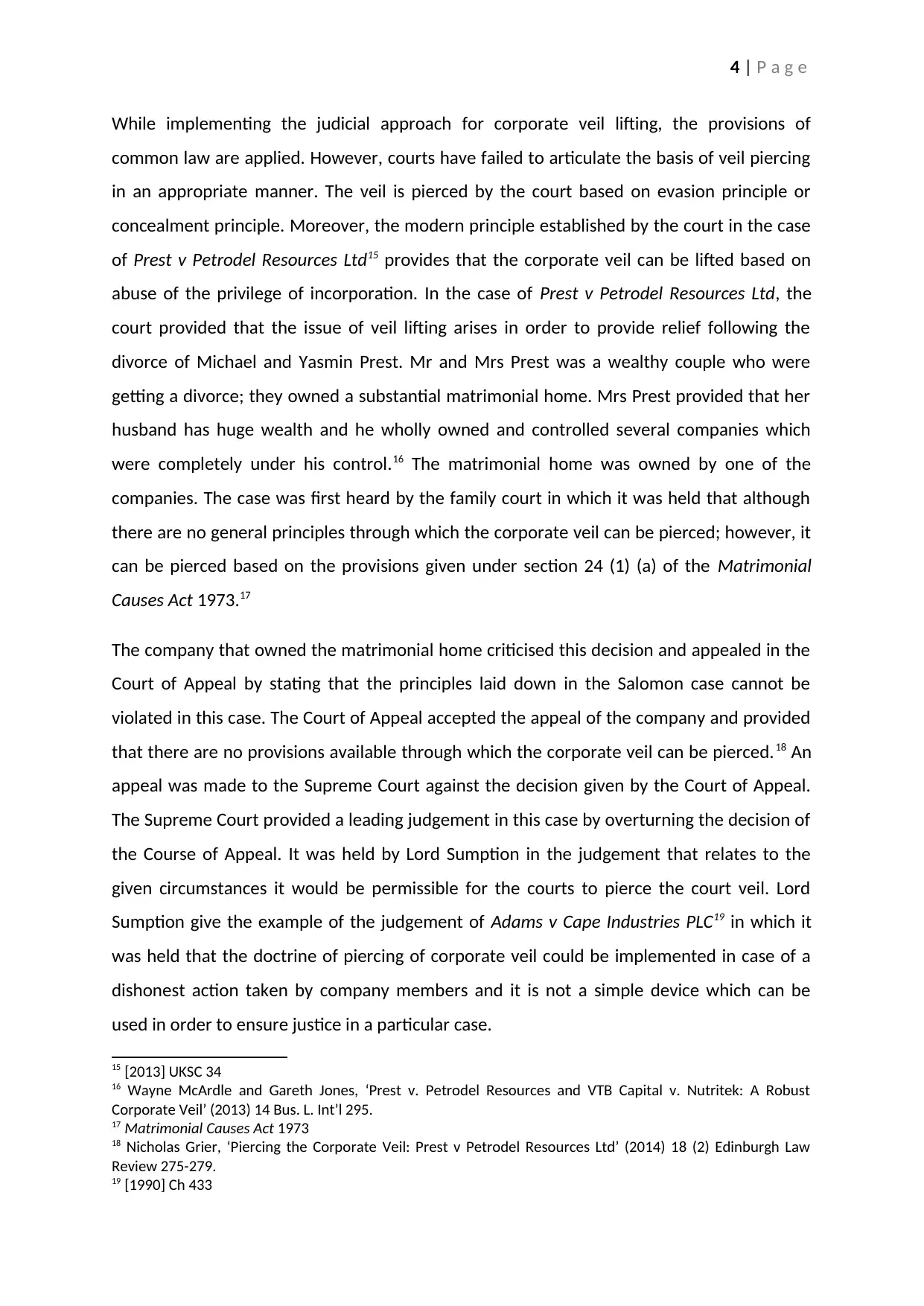
4 | P a g e
While implementing the judicial approach for corporate veil lifting, the provisions of
common law are applied. However, courts have failed to articulate the basis of veil piercing
in an appropriate manner. The veil is pierced by the court based on evasion principle or
concealment principle. Moreover, the modern principle established by the court in the case
of Prest v Petrodel Resources Ltd15 provides that the corporate veil can be lifted based on
abuse of the privilege of incorporation. In the case of Prest v Petrodel Resources Ltd, the
court provided that the issue of veil lifting arises in order to provide relief following the
divorce of Michael and Yasmin Prest. Mr and Mrs Prest was a wealthy couple who were
getting a divorce; they owned a substantial matrimonial home. Mrs Prest provided that her
husband has huge wealth and he wholly owned and controlled several companies which
were completely under his control.16 The matrimonial home was owned by one of the
companies. The case was first heard by the family court in which it was held that although
there are no general principles through which the corporate veil can be pierced; however, it
can be pierced based on the provisions given under section 24 (1) (a) of the Matrimonial
Causes Act 1973.17
The company that owned the matrimonial home criticised this decision and appealed in the
Court of Appeal by stating that the principles laid down in the Salomon case cannot be
violated in this case. The Court of Appeal accepted the appeal of the company and provided
that there are no provisions available through which the corporate veil can be pierced.18 An
appeal was made to the Supreme Court against the decision given by the Court of Appeal.
The Supreme Court provided a leading judgement in this case by overturning the decision of
the Course of Appeal. It was held by Lord Sumption in the judgement that relates to the
given circumstances it would be permissible for the courts to pierce the court veil. Lord
Sumption give the example of the judgement of Adams v Cape Industries PLC19 in which it
was held that the doctrine of piercing of corporate veil could be implemented in case of a
dishonest action taken by company members and it is not a simple device which can be
used in order to ensure justice in a particular case.
15 [2013] UKSC 34
16 Wayne McArdle and Gareth Jones, ‘Prest v. Petrodel Resources and VTB Capital v. Nutritek: A Robust
Corporate Veil’ (2013) 14 Bus. L. Int’l 295.
17 Matrimonial Causes Act 1973
18 Nicholas Grier, ‘Piercing the Corporate Veil: Prest v Petrodel Resources Ltd’ (2014) 18 (2) Edinburgh Law
Review 275-279.
19 [1990] Ch 433
While implementing the judicial approach for corporate veil lifting, the provisions of
common law are applied. However, courts have failed to articulate the basis of veil piercing
in an appropriate manner. The veil is pierced by the court based on evasion principle or
concealment principle. Moreover, the modern principle established by the court in the case
of Prest v Petrodel Resources Ltd15 provides that the corporate veil can be lifted based on
abuse of the privilege of incorporation. In the case of Prest v Petrodel Resources Ltd, the
court provided that the issue of veil lifting arises in order to provide relief following the
divorce of Michael and Yasmin Prest. Mr and Mrs Prest was a wealthy couple who were
getting a divorce; they owned a substantial matrimonial home. Mrs Prest provided that her
husband has huge wealth and he wholly owned and controlled several companies which
were completely under his control.16 The matrimonial home was owned by one of the
companies. The case was first heard by the family court in which it was held that although
there are no general principles through which the corporate veil can be pierced; however, it
can be pierced based on the provisions given under section 24 (1) (a) of the Matrimonial
Causes Act 1973.17
The company that owned the matrimonial home criticised this decision and appealed in the
Court of Appeal by stating that the principles laid down in the Salomon case cannot be
violated in this case. The Court of Appeal accepted the appeal of the company and provided
that there are no provisions available through which the corporate veil can be pierced.18 An
appeal was made to the Supreme Court against the decision given by the Court of Appeal.
The Supreme Court provided a leading judgement in this case by overturning the decision of
the Course of Appeal. It was held by Lord Sumption in the judgement that relates to the
given circumstances it would be permissible for the courts to pierce the court veil. Lord
Sumption give the example of the judgement of Adams v Cape Industries PLC19 in which it
was held that the doctrine of piercing of corporate veil could be implemented in case of a
dishonest action taken by company members and it is not a simple device which can be
used in order to ensure justice in a particular case.
15 [2013] UKSC 34
16 Wayne McArdle and Gareth Jones, ‘Prest v. Petrodel Resources and VTB Capital v. Nutritek: A Robust
Corporate Veil’ (2013) 14 Bus. L. Int’l 295.
17 Matrimonial Causes Act 1973
18 Nicholas Grier, ‘Piercing the Corporate Veil: Prest v Petrodel Resources Ltd’ (2014) 18 (2) Edinburgh Law
Review 275-279.
19 [1990] Ch 433
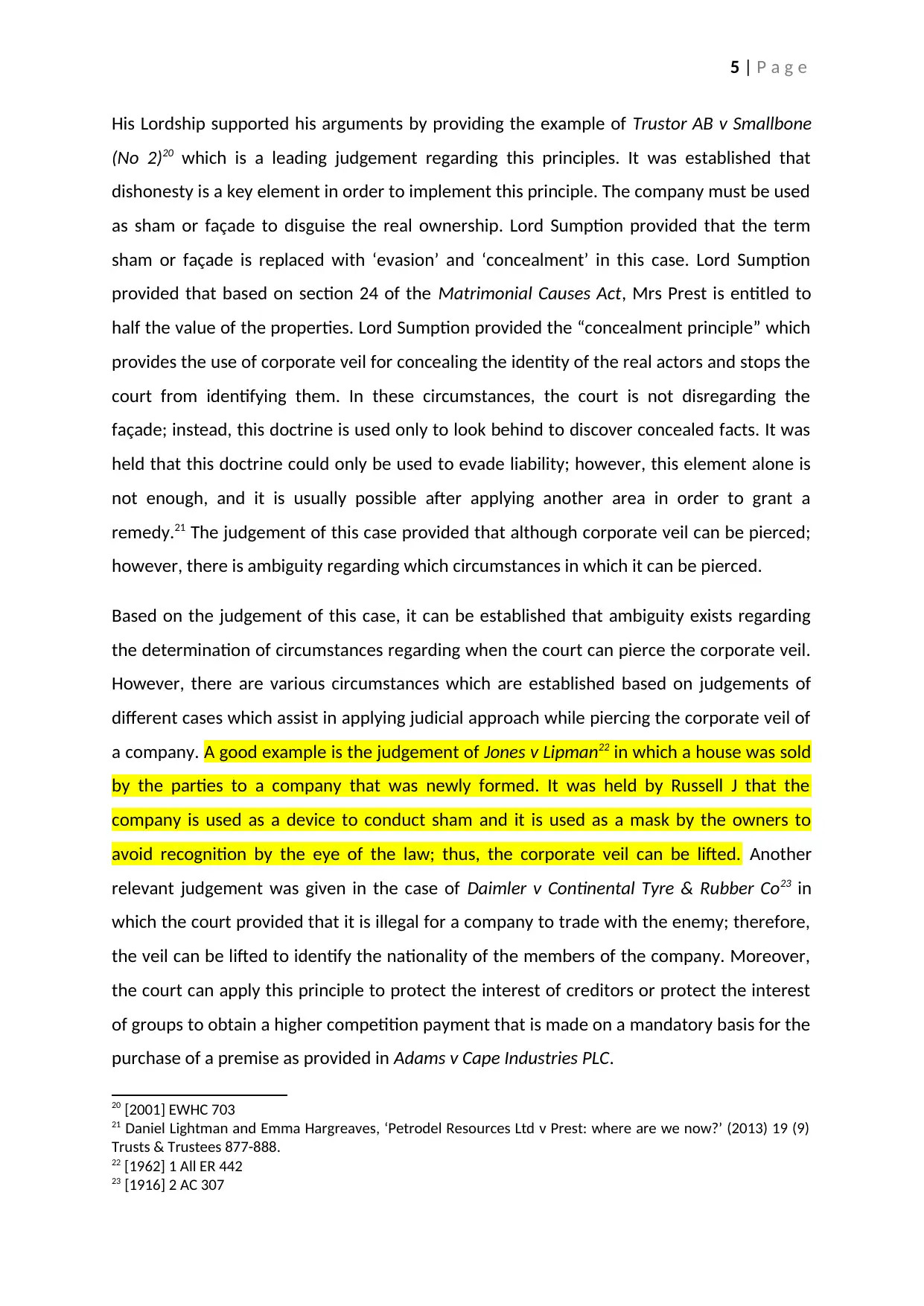
5 | P a g e
His Lordship supported his arguments by providing the example of Trustor AB v Smallbone
(No 2)20 which is a leading judgement regarding this principles. It was established that
dishonesty is a key element in order to implement this principle. The company must be used
as sham or façade to disguise the real ownership. Lord Sumption provided that the term
sham or façade is replaced with ‘evasion’ and ‘concealment’ in this case. Lord Sumption
provided that based on section 24 of the Matrimonial Causes Act, Mrs Prest is entitled to
half the value of the properties. Lord Sumption provided the “concealment principle” which
provides the use of corporate veil for concealing the identity of the real actors and stops the
court from identifying them. In these circumstances, the court is not disregarding the
façade; instead, this doctrine is used only to look behind to discover concealed facts. It was
held that this doctrine could only be used to evade liability; however, this element alone is
not enough, and it is usually possible after applying another area in order to grant a
remedy.21 The judgement of this case provided that although corporate veil can be pierced;
however, there is ambiguity regarding which circumstances in which it can be pierced.
Based on the judgement of this case, it can be established that ambiguity exists regarding
the determination of circumstances regarding when the court can pierce the corporate veil.
However, there are various circumstances which are established based on judgements of
different cases which assist in applying judicial approach while piercing the corporate veil of
a company. A good example is the judgement of Jones v Lipman22 in which a house was sold
by the parties to a company that was newly formed. It was held by Russell J that the
company is used as a device to conduct sham and it is used as a mask by the owners to
avoid recognition by the eye of the law; thus, the corporate veil can be lifted. Another
relevant judgement was given in the case of Daimler v Continental Tyre & Rubber Co23 in
which the court provided that it is illegal for a company to trade with the enemy; therefore,
the veil can be lifted to identify the nationality of the members of the company. Moreover,
the court can apply this principle to protect the interest of creditors or protect the interest
of groups to obtain a higher competition payment that is made on a mandatory basis for the
purchase of a premise as provided in Adams v Cape Industries PLC.
20 [2001] EWHC 703
21 Daniel Lightman and Emma Hargreaves, ‘Petrodel Resources Ltd v Prest: where are we now?’ (2013) 19 (9)
Trusts & Trustees 877-888.
22 [1962] 1 All ER 442
23 [1916] 2 AC 307
His Lordship supported his arguments by providing the example of Trustor AB v Smallbone
(No 2)20 which is a leading judgement regarding this principles. It was established that
dishonesty is a key element in order to implement this principle. The company must be used
as sham or façade to disguise the real ownership. Lord Sumption provided that the term
sham or façade is replaced with ‘evasion’ and ‘concealment’ in this case. Lord Sumption
provided that based on section 24 of the Matrimonial Causes Act, Mrs Prest is entitled to
half the value of the properties. Lord Sumption provided the “concealment principle” which
provides the use of corporate veil for concealing the identity of the real actors and stops the
court from identifying them. In these circumstances, the court is not disregarding the
façade; instead, this doctrine is used only to look behind to discover concealed facts. It was
held that this doctrine could only be used to evade liability; however, this element alone is
not enough, and it is usually possible after applying another area in order to grant a
remedy.21 The judgement of this case provided that although corporate veil can be pierced;
however, there is ambiguity regarding which circumstances in which it can be pierced.
Based on the judgement of this case, it can be established that ambiguity exists regarding
the determination of circumstances regarding when the court can pierce the corporate veil.
However, there are various circumstances which are established based on judgements of
different cases which assist in applying judicial approach while piercing the corporate veil of
a company. A good example is the judgement of Jones v Lipman22 in which a house was sold
by the parties to a company that was newly formed. It was held by Russell J that the
company is used as a device to conduct sham and it is used as a mask by the owners to
avoid recognition by the eye of the law; thus, the corporate veil can be lifted. Another
relevant judgement was given in the case of Daimler v Continental Tyre & Rubber Co23 in
which the court provided that it is illegal for a company to trade with the enemy; therefore,
the veil can be lifted to identify the nationality of the members of the company. Moreover,
the court can apply this principle to protect the interest of creditors or protect the interest
of groups to obtain a higher competition payment that is made on a mandatory basis for the
purchase of a premise as provided in Adams v Cape Industries PLC.
20 [2001] EWHC 703
21 Daniel Lightman and Emma Hargreaves, ‘Petrodel Resources Ltd v Prest: where are we now?’ (2013) 19 (9)
Trusts & Trustees 877-888.
22 [1962] 1 All ER 442
23 [1916] 2 AC 307
⊘ This is a preview!⊘
Do you want full access?
Subscribe today to unlock all pages.

Trusted by 1+ million students worldwide
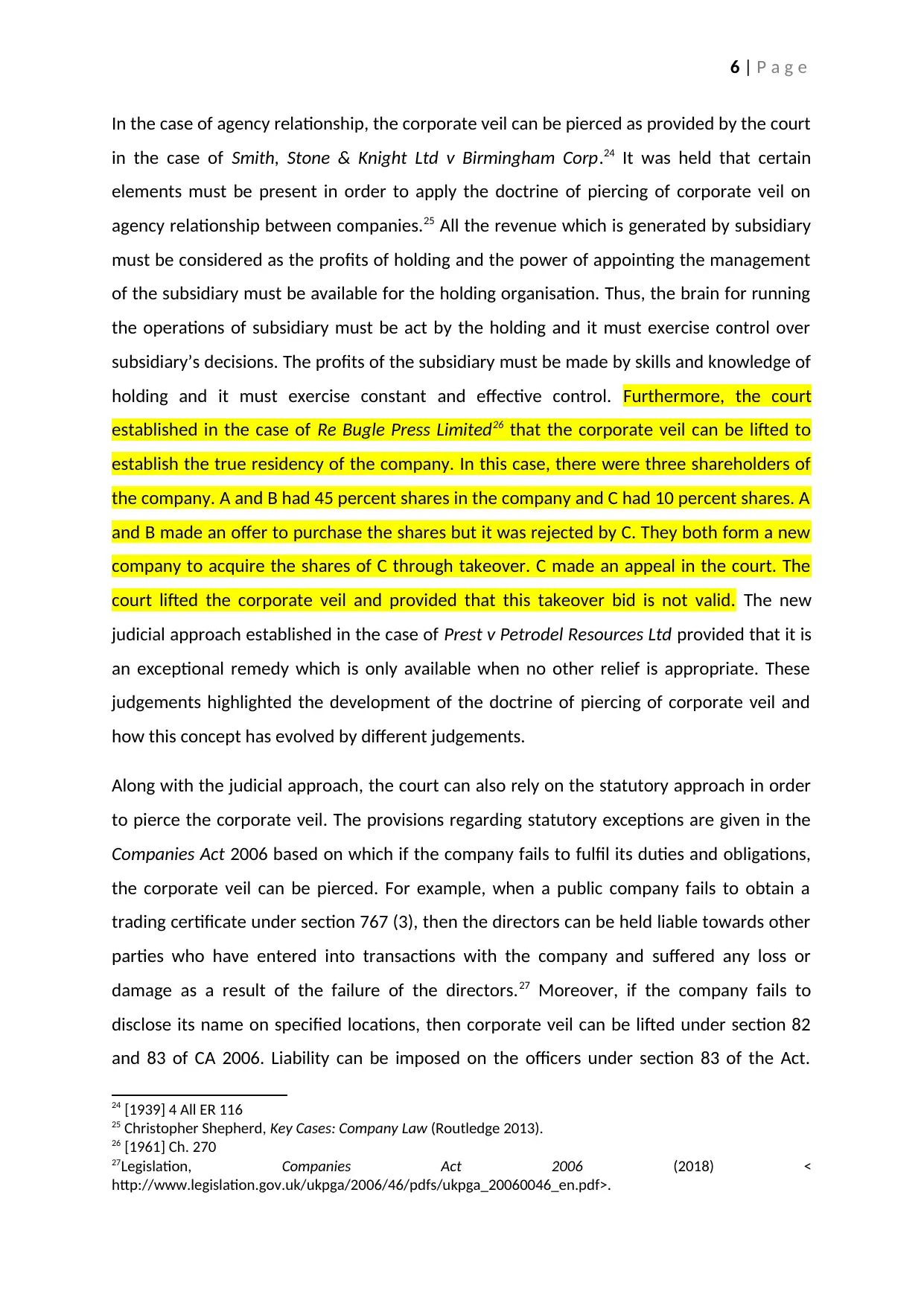
6 | P a g e
In the case of agency relationship, the corporate veil can be pierced as provided by the court
in the case of Smith, Stone & Knight Ltd v Birmingham Corp.24 It was held that certain
elements must be present in order to apply the doctrine of piercing of corporate veil on
agency relationship between companies.25 All the revenue which is generated by subsidiary
must be considered as the profits of holding and the power of appointing the management
of the subsidiary must be available for the holding organisation. Thus, the brain for running
the operations of subsidiary must be act by the holding and it must exercise control over
subsidiary’s decisions. The profits of the subsidiary must be made by skills and knowledge of
holding and it must exercise constant and effective control. Furthermore, the court
established in the case of Re Bugle Press Limited26 that the corporate veil can be lifted to
establish the true residency of the company. In this case, there were three shareholders of
the company. A and B had 45 percent shares in the company and C had 10 percent shares. A
and B made an offer to purchase the shares but it was rejected by C. They both form a new
company to acquire the shares of C through takeover. C made an appeal in the court. The
court lifted the corporate veil and provided that this takeover bid is not valid. The new
judicial approach established in the case of Prest v Petrodel Resources Ltd provided that it is
an exceptional remedy which is only available when no other relief is appropriate. These
judgements highlighted the development of the doctrine of piercing of corporate veil and
how this concept has evolved by different judgements.
Along with the judicial approach, the court can also rely on the statutory approach in order
to pierce the corporate veil. The provisions regarding statutory exceptions are given in the
Companies Act 2006 based on which if the company fails to fulfil its duties and obligations,
the corporate veil can be pierced. For example, when a public company fails to obtain a
trading certificate under section 767 (3), then the directors can be held liable towards other
parties who have entered into transactions with the company and suffered any loss or
damage as a result of the failure of the directors.27 Moreover, if the company fails to
disclose its name on specified locations, then corporate veil can be lifted under section 82
and 83 of CA 2006. Liability can be imposed on the officers under section 83 of the Act.
24 [1939] 4 All ER 116
25 Christopher Shepherd, Key Cases: Company Law (Routledge 2013).
26 [1961] Ch. 270
27Legislation, Companies Act 2006 (2018) <
http://www.legislation.gov.uk/ukpga/2006/46/pdfs/ukpga_20060046_en.pdf>.
In the case of agency relationship, the corporate veil can be pierced as provided by the court
in the case of Smith, Stone & Knight Ltd v Birmingham Corp.24 It was held that certain
elements must be present in order to apply the doctrine of piercing of corporate veil on
agency relationship between companies.25 All the revenue which is generated by subsidiary
must be considered as the profits of holding and the power of appointing the management
of the subsidiary must be available for the holding organisation. Thus, the brain for running
the operations of subsidiary must be act by the holding and it must exercise control over
subsidiary’s decisions. The profits of the subsidiary must be made by skills and knowledge of
holding and it must exercise constant and effective control. Furthermore, the court
established in the case of Re Bugle Press Limited26 that the corporate veil can be lifted to
establish the true residency of the company. In this case, there were three shareholders of
the company. A and B had 45 percent shares in the company and C had 10 percent shares. A
and B made an offer to purchase the shares but it was rejected by C. They both form a new
company to acquire the shares of C through takeover. C made an appeal in the court. The
court lifted the corporate veil and provided that this takeover bid is not valid. The new
judicial approach established in the case of Prest v Petrodel Resources Ltd provided that it is
an exceptional remedy which is only available when no other relief is appropriate. These
judgements highlighted the development of the doctrine of piercing of corporate veil and
how this concept has evolved by different judgements.
Along with the judicial approach, the court can also rely on the statutory approach in order
to pierce the corporate veil. The provisions regarding statutory exceptions are given in the
Companies Act 2006 based on which if the company fails to fulfil its duties and obligations,
the corporate veil can be pierced. For example, when a public company fails to obtain a
trading certificate under section 767 (3), then the directors can be held liable towards other
parties who have entered into transactions with the company and suffered any loss or
damage as a result of the failure of the directors.27 Moreover, if the company fails to
disclose its name on specified locations, then corporate veil can be lifted under section 82
and 83 of CA 2006. Liability can be imposed on the officers under section 83 of the Act.
24 [1939] 4 All ER 116
25 Christopher Shepherd, Key Cases: Company Law (Routledge 2013).
26 [1961] Ch. 270
27Legislation, Companies Act 2006 (2018) <
http://www.legislation.gov.uk/ukpga/2006/46/pdfs/ukpga_20060046_en.pdf>.
Paraphrase This Document
Need a fresh take? Get an instant paraphrase of this document with our AI Paraphraser
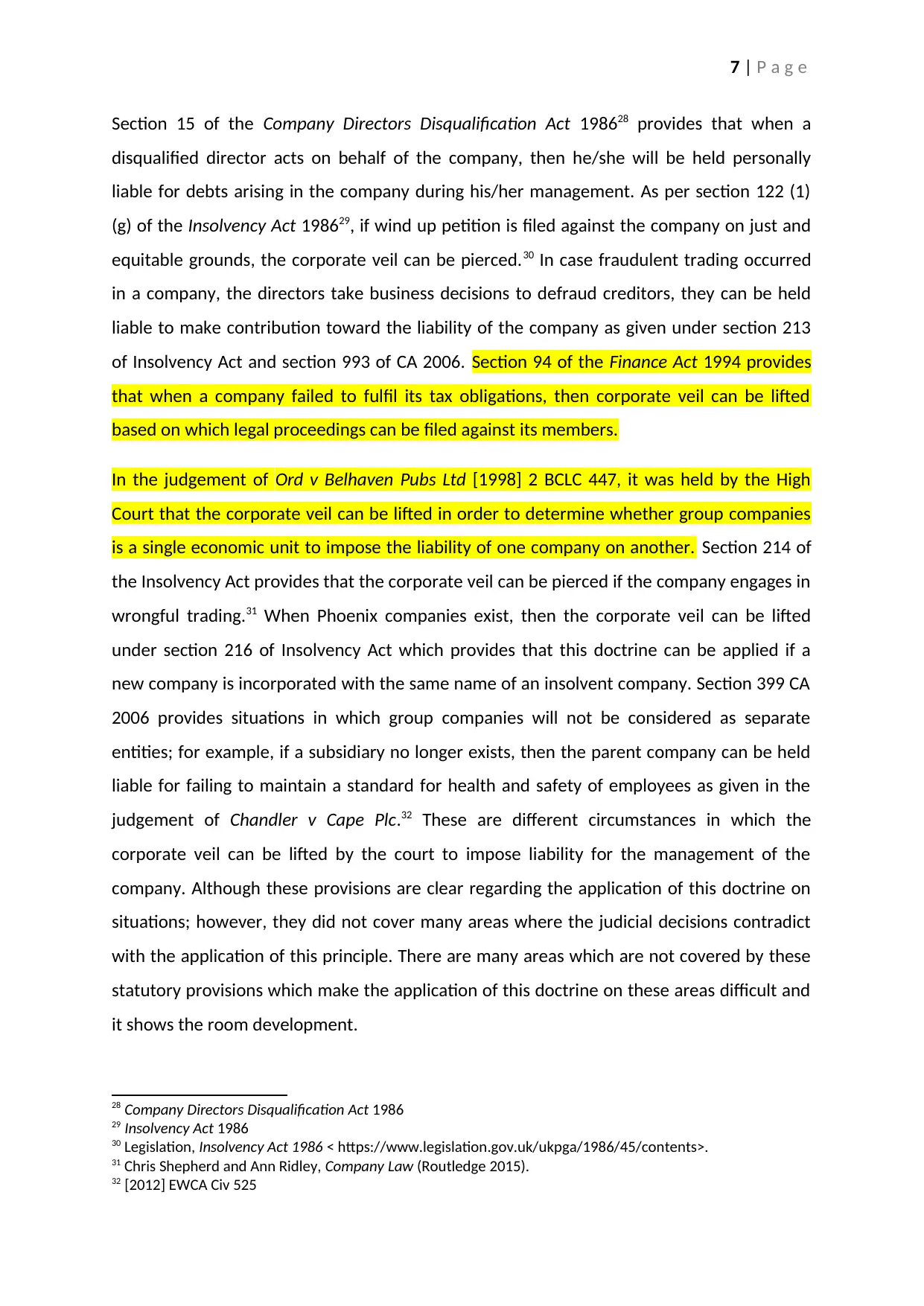
7 | P a g e
Section 15 of the Company Directors Disqualification Act 198628 provides that when a
disqualified director acts on behalf of the company, then he/she will be held personally
liable for debts arising in the company during his/her management. As per section 122 (1)
(g) of the Insolvency Act 198629, if wind up petition is filed against the company on just and
equitable grounds, the corporate veil can be pierced.30 In case fraudulent trading occurred
in a company, the directors take business decisions to defraud creditors, they can be held
liable to make contribution toward the liability of the company as given under section 213
of Insolvency Act and section 993 of CA 2006. Section 94 of the Finance Act 1994 provides
that when a company failed to fulfil its tax obligations, then corporate veil can be lifted
based on which legal proceedings can be filed against its members.
In the judgement of Ord v Belhaven Pubs Ltd [1998] 2 BCLC 447, it was held by the High
Court that the corporate veil can be lifted in order to determine whether group companies
is a single economic unit to impose the liability of one company on another. Section 214 of
the Insolvency Act provides that the corporate veil can be pierced if the company engages in
wrongful trading.31 When Phoenix companies exist, then the corporate veil can be lifted
under section 216 of Insolvency Act which provides that this doctrine can be applied if a
new company is incorporated with the same name of an insolvent company. Section 399 CA
2006 provides situations in which group companies will not be considered as separate
entities; for example, if a subsidiary no longer exists, then the parent company can be held
liable for failing to maintain a standard for health and safety of employees as given in the
judgement of Chandler v Cape Plc.32 These are different circumstances in which the
corporate veil can be lifted by the court to impose liability for the management of the
company. Although these provisions are clear regarding the application of this doctrine on
situations; however, they did not cover many areas where the judicial decisions contradict
with the application of this principle. There are many areas which are not covered by these
statutory provisions which make the application of this doctrine on these areas difficult and
it shows the room development.
28 Company Directors Disqualification Act 1986
29 Insolvency Act 1986
30 Legislation, Insolvency Act 1986 < https://www.legislation.gov.uk/ukpga/1986/45/contents>.
31 Chris Shepherd and Ann Ridley, Company Law (Routledge 2015).
32 [2012] EWCA Civ 525
Section 15 of the Company Directors Disqualification Act 198628 provides that when a
disqualified director acts on behalf of the company, then he/she will be held personally
liable for debts arising in the company during his/her management. As per section 122 (1)
(g) of the Insolvency Act 198629, if wind up petition is filed against the company on just and
equitable grounds, the corporate veil can be pierced.30 In case fraudulent trading occurred
in a company, the directors take business decisions to defraud creditors, they can be held
liable to make contribution toward the liability of the company as given under section 213
of Insolvency Act and section 993 of CA 2006. Section 94 of the Finance Act 1994 provides
that when a company failed to fulfil its tax obligations, then corporate veil can be lifted
based on which legal proceedings can be filed against its members.
In the judgement of Ord v Belhaven Pubs Ltd [1998] 2 BCLC 447, it was held by the High
Court that the corporate veil can be lifted in order to determine whether group companies
is a single economic unit to impose the liability of one company on another. Section 214 of
the Insolvency Act provides that the corporate veil can be pierced if the company engages in
wrongful trading.31 When Phoenix companies exist, then the corporate veil can be lifted
under section 216 of Insolvency Act which provides that this doctrine can be applied if a
new company is incorporated with the same name of an insolvent company. Section 399 CA
2006 provides situations in which group companies will not be considered as separate
entities; for example, if a subsidiary no longer exists, then the parent company can be held
liable for failing to maintain a standard for health and safety of employees as given in the
judgement of Chandler v Cape Plc.32 These are different circumstances in which the
corporate veil can be lifted by the court to impose liability for the management of the
company. Although these provisions are clear regarding the application of this doctrine on
situations; however, they did not cover many areas where the judicial decisions contradict
with the application of this principle. There are many areas which are not covered by these
statutory provisions which make the application of this doctrine on these areas difficult and
it shows the room development.
28 Company Directors Disqualification Act 1986
29 Insolvency Act 1986
30 Legislation, Insolvency Act 1986 < https://www.legislation.gov.uk/ukpga/1986/45/contents>.
31 Chris Shepherd and Ann Ridley, Company Law (Routledge 2015).
32 [2012] EWCA Civ 525
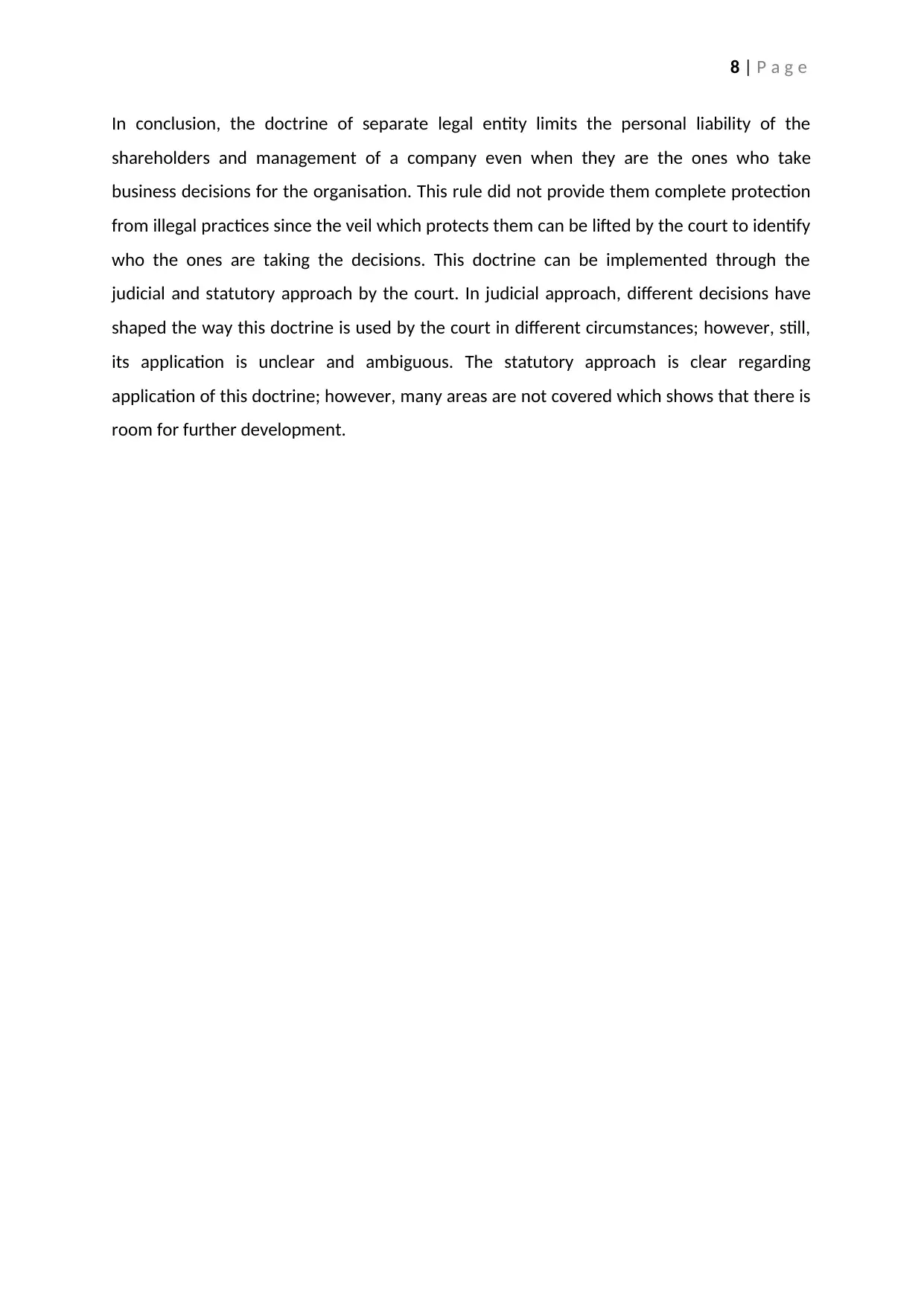
8 | P a g e
In conclusion, the doctrine of separate legal entity limits the personal liability of the
shareholders and management of a company even when they are the ones who take
business decisions for the organisation. This rule did not provide them complete protection
from illegal practices since the veil which protects them can be lifted by the court to identify
who the ones are taking the decisions. This doctrine can be implemented through the
judicial and statutory approach by the court. In judicial approach, different decisions have
shaped the way this doctrine is used by the court in different circumstances; however, still,
its application is unclear and ambiguous. The statutory approach is clear regarding
application of this doctrine; however, many areas are not covered which shows that there is
room for further development.
In conclusion, the doctrine of separate legal entity limits the personal liability of the
shareholders and management of a company even when they are the ones who take
business decisions for the organisation. This rule did not provide them complete protection
from illegal practices since the veil which protects them can be lifted by the court to identify
who the ones are taking the decisions. This doctrine can be implemented through the
judicial and statutory approach by the court. In judicial approach, different decisions have
shaped the way this doctrine is used by the court in different circumstances; however, still,
its application is unclear and ambiguous. The statutory approach is clear regarding
application of this doctrine; however, many areas are not covered which shows that there is
room for further development.
⊘ This is a preview!⊘
Do you want full access?
Subscribe today to unlock all pages.

Trusted by 1+ million students worldwide
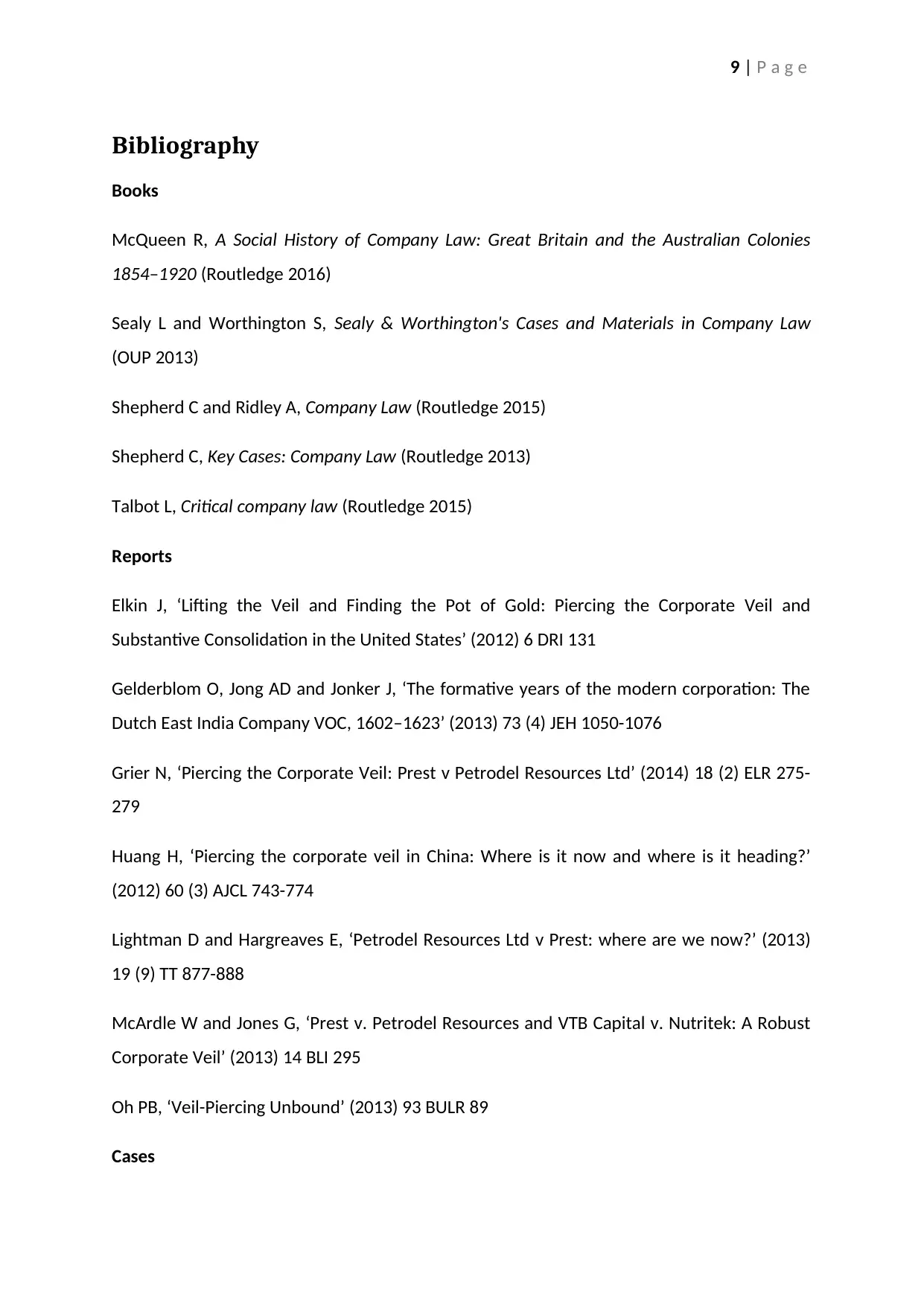
9 | P a g e
Bibliography
Books
McQueen R, A Social History of Company Law: Great Britain and the Australian Colonies
1854–1920 (Routledge 2016)
Sealy L and Worthington S, Sealy & Worthington's Cases and Materials in Company Law
(OUP 2013)
Shepherd C and Ridley A, Company Law (Routledge 2015)
Shepherd C, Key Cases: Company Law (Routledge 2013)
Talbot L, Critical company law (Routledge 2015)
Reports
Elkin J, ‘Lifting the Veil and Finding the Pot of Gold: Piercing the Corporate Veil and
Substantive Consolidation in the United States’ (2012) 6 DRI 131
Gelderblom O, Jong AD and Jonker J, ‘The formative years of the modern corporation: The
Dutch East India Company VOC, 1602–1623’ (2013) 73 (4) JEH 1050-1076
Grier N, ‘Piercing the Corporate Veil: Prest v Petrodel Resources Ltd’ (2014) 18 (2) ELR 275-
279
Huang H, ‘Piercing the corporate veil in China: Where is it now and where is it heading?’
(2012) 60 (3) AJCL 743-774
Lightman D and Hargreaves E, ‘Petrodel Resources Ltd v Prest: where are we now?’ (2013)
19 (9) TT 877-888
McArdle W and Jones G, ‘Prest v. Petrodel Resources and VTB Capital v. Nutritek: A Robust
Corporate Veil’ (2013) 14 BLI 295
Oh PB, ‘Veil-Piercing Unbound’ (2013) 93 BULR 89
Cases
Bibliography
Books
McQueen R, A Social History of Company Law: Great Britain and the Australian Colonies
1854–1920 (Routledge 2016)
Sealy L and Worthington S, Sealy & Worthington's Cases and Materials in Company Law
(OUP 2013)
Shepherd C and Ridley A, Company Law (Routledge 2015)
Shepherd C, Key Cases: Company Law (Routledge 2013)
Talbot L, Critical company law (Routledge 2015)
Reports
Elkin J, ‘Lifting the Veil and Finding the Pot of Gold: Piercing the Corporate Veil and
Substantive Consolidation in the United States’ (2012) 6 DRI 131
Gelderblom O, Jong AD and Jonker J, ‘The formative years of the modern corporation: The
Dutch East India Company VOC, 1602–1623’ (2013) 73 (4) JEH 1050-1076
Grier N, ‘Piercing the Corporate Veil: Prest v Petrodel Resources Ltd’ (2014) 18 (2) ELR 275-
279
Huang H, ‘Piercing the corporate veil in China: Where is it now and where is it heading?’
(2012) 60 (3) AJCL 743-774
Lightman D and Hargreaves E, ‘Petrodel Resources Ltd v Prest: where are we now?’ (2013)
19 (9) TT 877-888
McArdle W and Jones G, ‘Prest v. Petrodel Resources and VTB Capital v. Nutritek: A Robust
Corporate Veil’ (2013) 14 BLI 295
Oh PB, ‘Veil-Piercing Unbound’ (2013) 93 BULR 89
Cases
Paraphrase This Document
Need a fresh take? Get an instant paraphrase of this document with our AI Paraphraser
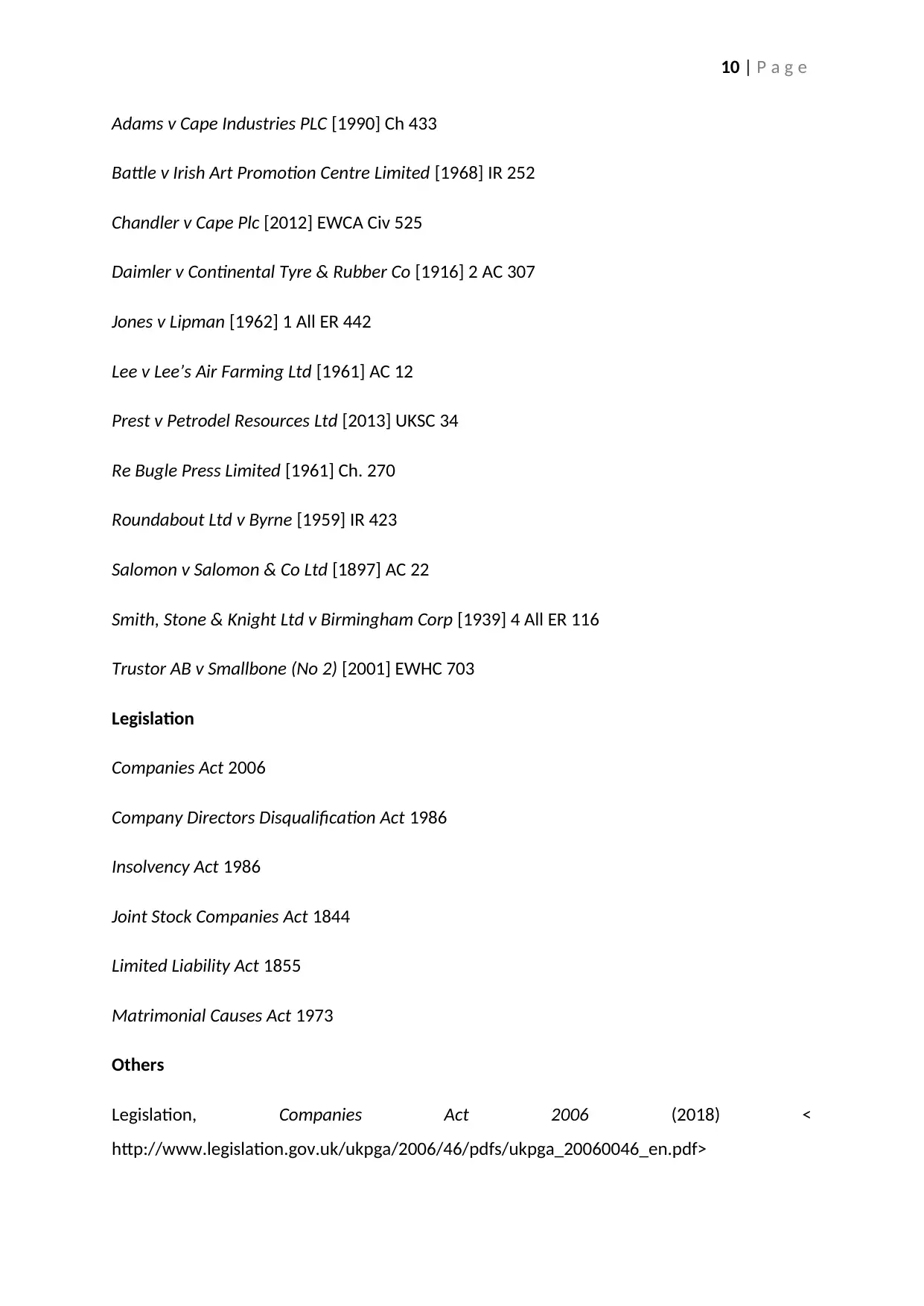
10 | P a g e
Adams v Cape Industries PLC [1990] Ch 433
Battle v Irish Art Promotion Centre Limited [1968] IR 252
Chandler v Cape Plc [2012] EWCA Civ 525
Daimler v Continental Tyre & Rubber Co [1916] 2 AC 307
Jones v Lipman [1962] 1 All ER 442
Lee v Lee’s Air Farming Ltd [1961] AC 12
Prest v Petrodel Resources Ltd [2013] UKSC 34
Re Bugle Press Limited [1961] Ch. 270
Roundabout Ltd v Byrne [1959] IR 423
Salomon v Salomon & Co Ltd [1897] AC 22
Smith, Stone & Knight Ltd v Birmingham Corp [1939] 4 All ER 116
Trustor AB v Smallbone (No 2) [2001] EWHC 703
Legislation
Companies Act 2006
Company Directors Disqualification Act 1986
Insolvency Act 1986
Joint Stock Companies Act 1844
Limited Liability Act 1855
Matrimonial Causes Act 1973
Others
Legislation, Companies Act 2006 (2018) <
http://www.legislation.gov.uk/ukpga/2006/46/pdfs/ukpga_20060046_en.pdf>
Adams v Cape Industries PLC [1990] Ch 433
Battle v Irish Art Promotion Centre Limited [1968] IR 252
Chandler v Cape Plc [2012] EWCA Civ 525
Daimler v Continental Tyre & Rubber Co [1916] 2 AC 307
Jones v Lipman [1962] 1 All ER 442
Lee v Lee’s Air Farming Ltd [1961] AC 12
Prest v Petrodel Resources Ltd [2013] UKSC 34
Re Bugle Press Limited [1961] Ch. 270
Roundabout Ltd v Byrne [1959] IR 423
Salomon v Salomon & Co Ltd [1897] AC 22
Smith, Stone & Knight Ltd v Birmingham Corp [1939] 4 All ER 116
Trustor AB v Smallbone (No 2) [2001] EWHC 703
Legislation
Companies Act 2006
Company Directors Disqualification Act 1986
Insolvency Act 1986
Joint Stock Companies Act 1844
Limited Liability Act 1855
Matrimonial Causes Act 1973
Others
Legislation, Companies Act 2006 (2018) <
http://www.legislation.gov.uk/ukpga/2006/46/pdfs/ukpga_20060046_en.pdf>

11 | P a g e
Legislation, Insolvency Act 1986 < https://www.legislation.gov.uk/ukpga/1986/45/contents>
Legislation, Insolvency Act 1986 < https://www.legislation.gov.uk/ukpga/1986/45/contents>
⊘ This is a preview!⊘
Do you want full access?
Subscribe today to unlock all pages.

Trusted by 1+ million students worldwide
1 out of 12
Related Documents
Your All-in-One AI-Powered Toolkit for Academic Success.
+13062052269
info@desklib.com
Available 24*7 on WhatsApp / Email
![[object Object]](/_next/static/media/star-bottom.7253800d.svg)
Unlock your academic potential
Copyright © 2020–2025 A2Z Services. All Rights Reserved. Developed and managed by ZUCOL.





